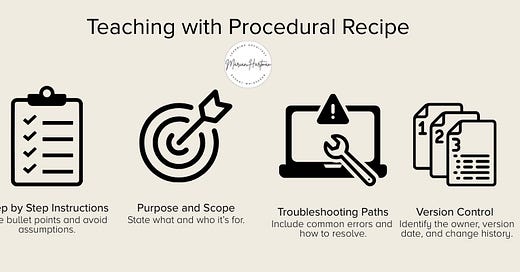It was that time of year again.
The Neighborhood Spring Yard Sale.
But wait... what did we do last time?
How did we advertise?
What signs did we use?
What was the process?
It only happens once a year, and while it seems simple, it’s packed with small details that are easy to forget.
That’s exactly why we created a procedural recipe, which are a few bullet points and templates that save hours of digging through digital clutter to recreate what we did before. Our neighborhood runbook is the difference between overwhelmed organizers and a smooth, stress-free event.
And while this is a domestic example, the value of a procedural recipe, or classic runbook, is just as powerful in the workplace. It frees people from relying on memory, guesswork, or informal tribal knowledge. Instead, it transforms potential chaos into a controlled, manageable situation—reducing downtime and stress.
In this newsletter, I’m diving deeper into what it takes to create reliable procedural recipes that help people build and maintain skills, especially when those skills are used infrequently.
What Makes a Great Runbook?
Clear, Step-by-Step Instructions
At the heart of every great runbook are simple, direct instructions. Break down tasks using numbered steps or bullet points. Avoid assuming the user has prior knowledge. Define acronyms, include screenshots or commands when needed, and keep formatting consistent. Clear steps reduce errors and help even new users complete tasks confidently and quickly.Defined Purpose and Scope
A good runbook starts by stating exactly why it exists and who it’s for. This helps users know if they’re in the right place and sets expectations. It also defines the boundaries—what systems or situations it covers—keeping the content focused and preventing confusion.Troubleshooting and Escalation Paths
Even with perfect steps, things can go wrong. This section prepares users for what to do when the unexpected happens. Include common issues, error messages, and fixes. And make sure users know when and how to escalate, with the right contact details and context, so problems are resolved quickly by the right people.Version Control and Maintenance Info
Runbooks are only useful if they’re up to date. Include the last updated date, the owner of the document, and a brief change history. This builds trust and ensures that what’s written still works. Regular maintenance also makes it easier to improve and adapt as things evolve.
When and Why Would I Use a Runbook?
Runbooks are perfect for:
Infrequently performed complex procedures. The definition of infrequently is the span of time where people can forget the details.
Procedures where consistency matters.
Procedures that include delays or waiting for another event or stakeholder.
Big Picture Context
Most of my writing is framed through The Green Path, my model for acquiring skills effectively and at scale. This month, we’re focusing on Block 2. This is the phase where people are eager, experimenting, and hungry for direction. Procedural recipes and runbooks are perfect tools for providing that guidance when it matters most.
Attend the free webinar to find out details and how my masterclass on applying The Green Path will change your life!






